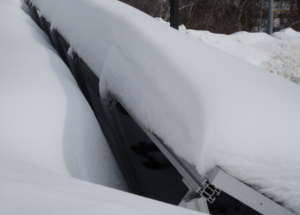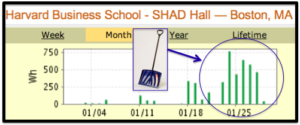
As Boston faces its fourth major snow storm in a month many New Englanders have sunk deep into the “dark months” blues. And each day as I stare at Groom Energy’s snow-covered solar array I can’t dismiss some level of guilt for our environmental faux pas.
But with storms January 12th, 20th, 26th and tomorrow’s monster, I’m left wondering whether we should bother reducing global warming by shoveling tomorrow? or maybe wait a few more days since another storm is probably coming anyway.
A quick look at Fat Spaniel’s solar performance site confirms a variety of approaches to this decision. Some shovel. Some wait for it to melt. Some wait, then shovel, then another storm comes – do they shovel again? You get the picture.
After this past week’s storm the folks at Harvard Business School broke out their shovels while Salem State University focused instead on their studies.

Although HBS feels greener for the effort, their shoveling investment calculation should be based on the Y-axis of the Fat Spaniel performance graph – ie. kilowatt hours produced – vs. snow covered kilowatt hours. And how long they think until the next storm hits…
What’s the payback for shoveling? Are the folks at Harvard Business School or Salem State better investors?
As with all things energy related, its entirely based on the math – and the assumptions.
We made the following for Harvard and Salem State:
Cost of Solar Array:
System size: 100kw monocrystalline
Current cost of electricity per kWh: $0.12
Escalation rate: 3% per year
Total cost of original installation (circa 2010 at $5 per watt): $501,400
NPV of MA SREC’s value @ $0.285 kWh: $254,194
No Federal incentive as Harvard and Salem State are tax-exempt.
Therefore, total net cost: $247,206
Our solar energy model says this system’s average daily production in January is 171.4 kWh per day so the cash flow payback is @ 10 years.
Cost of Shoveling:
Hourly rate (laborer prevailing wage): $15.00
Number of panels (230 watt): 436
Minutes to fully clear a panel: 2
Efficiency: 8 hour day/1 hour of break
Therefore the estimated cost to shovel the 100kW solar array: $249 (+ $14 for shovel)
Cost Benefit for Shoveling:
Interestingly, while the value for the daily solar energy production for this system is only $20.60, the value for the daily Massachusetts SREC production is $48.85.
So the daily economic benefit for shoveling is $69.41 – or a breakeven of 3.6 days.
Which, as it turns out, is almost exactly when the next snow storm hit us.
Maybe the HBS folks figured out that in today’s economic climate getting your original investment back isn’t that bad a deal?
Or maybe Salem State just has a better meteorology department.

